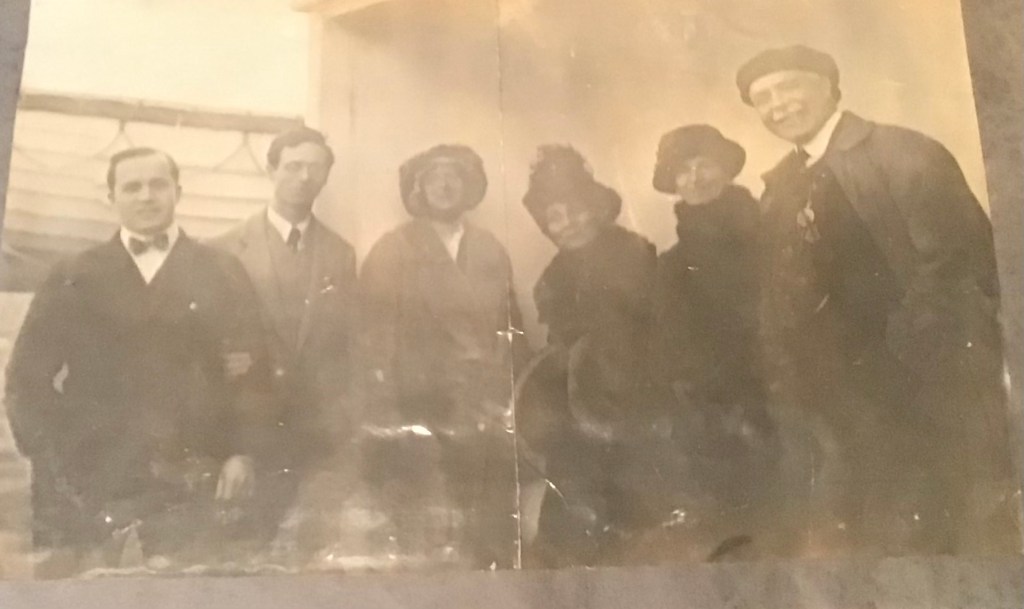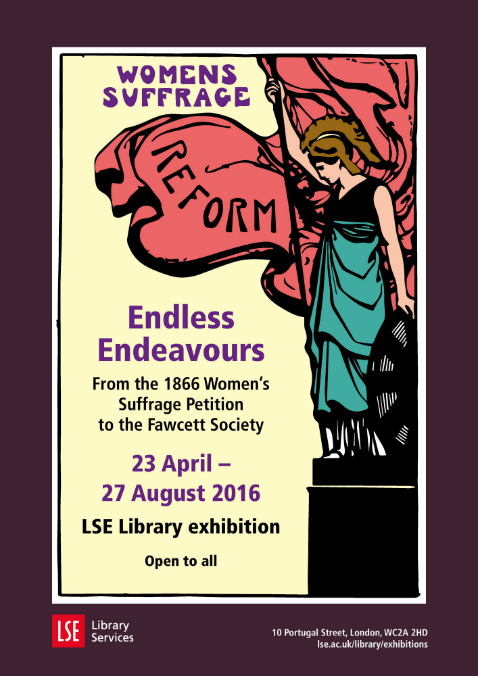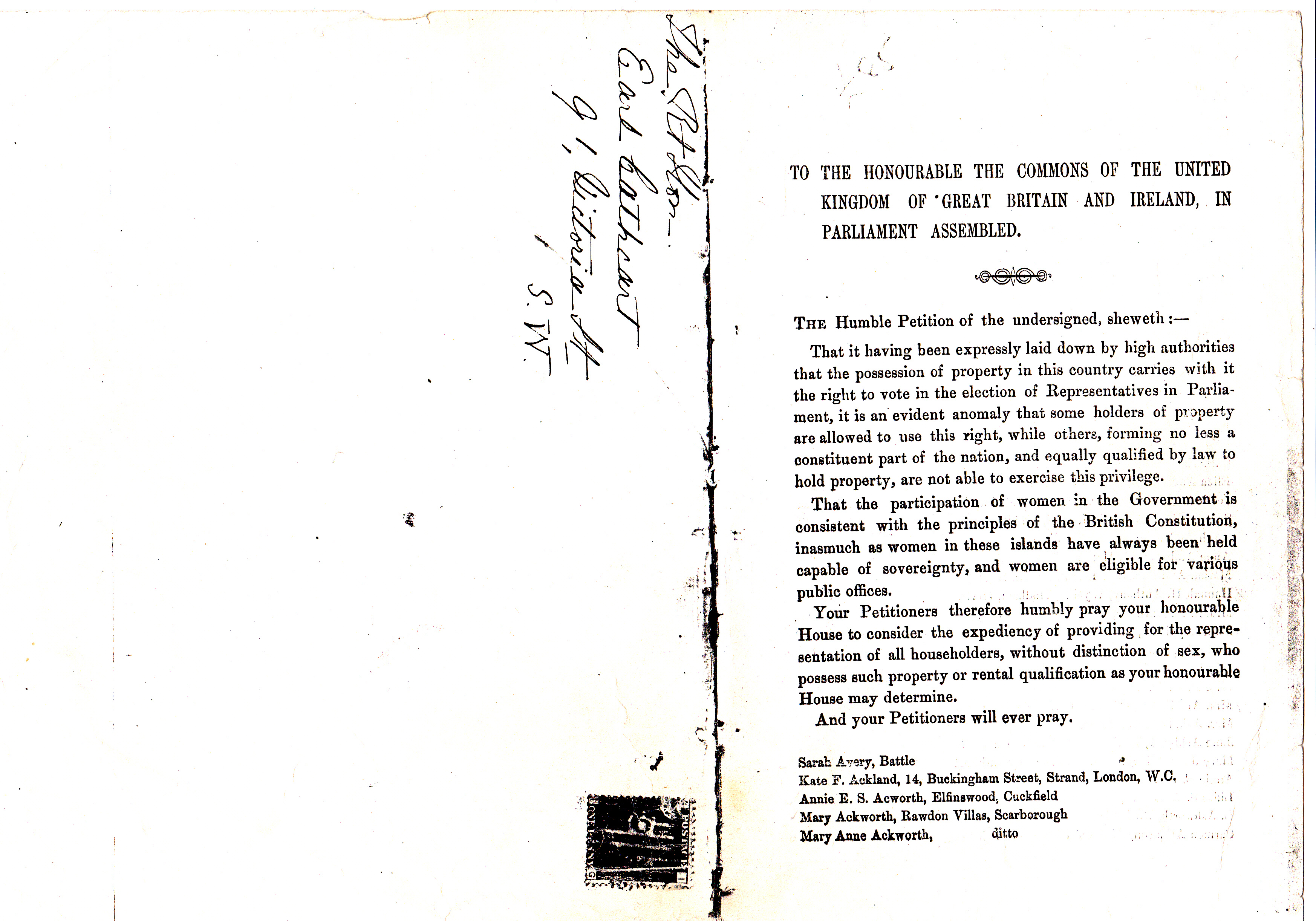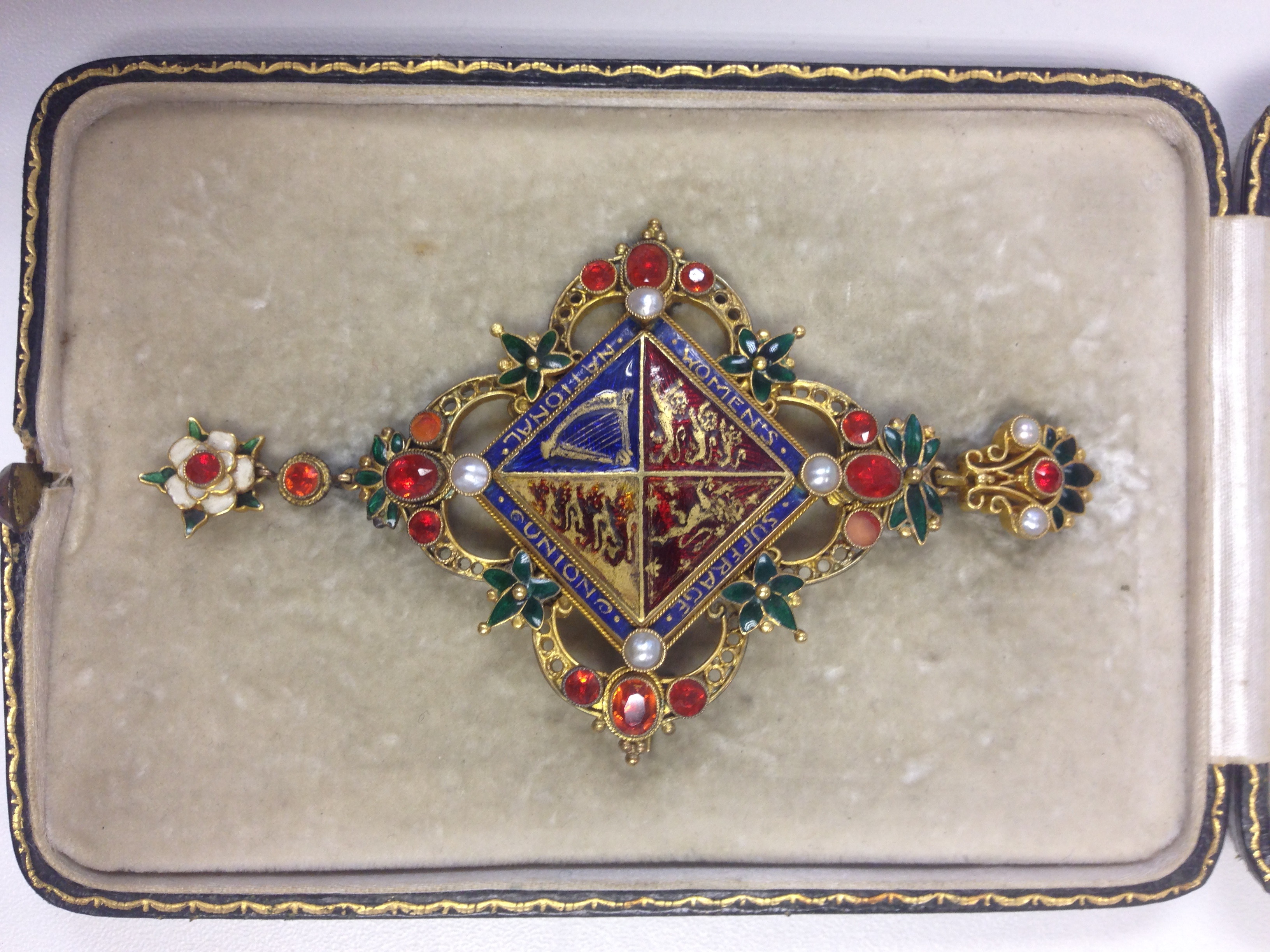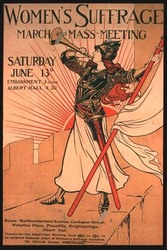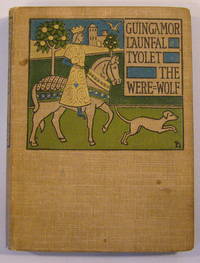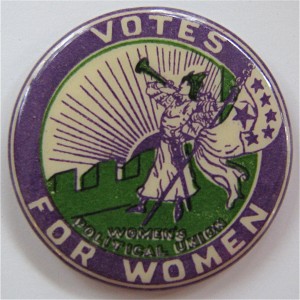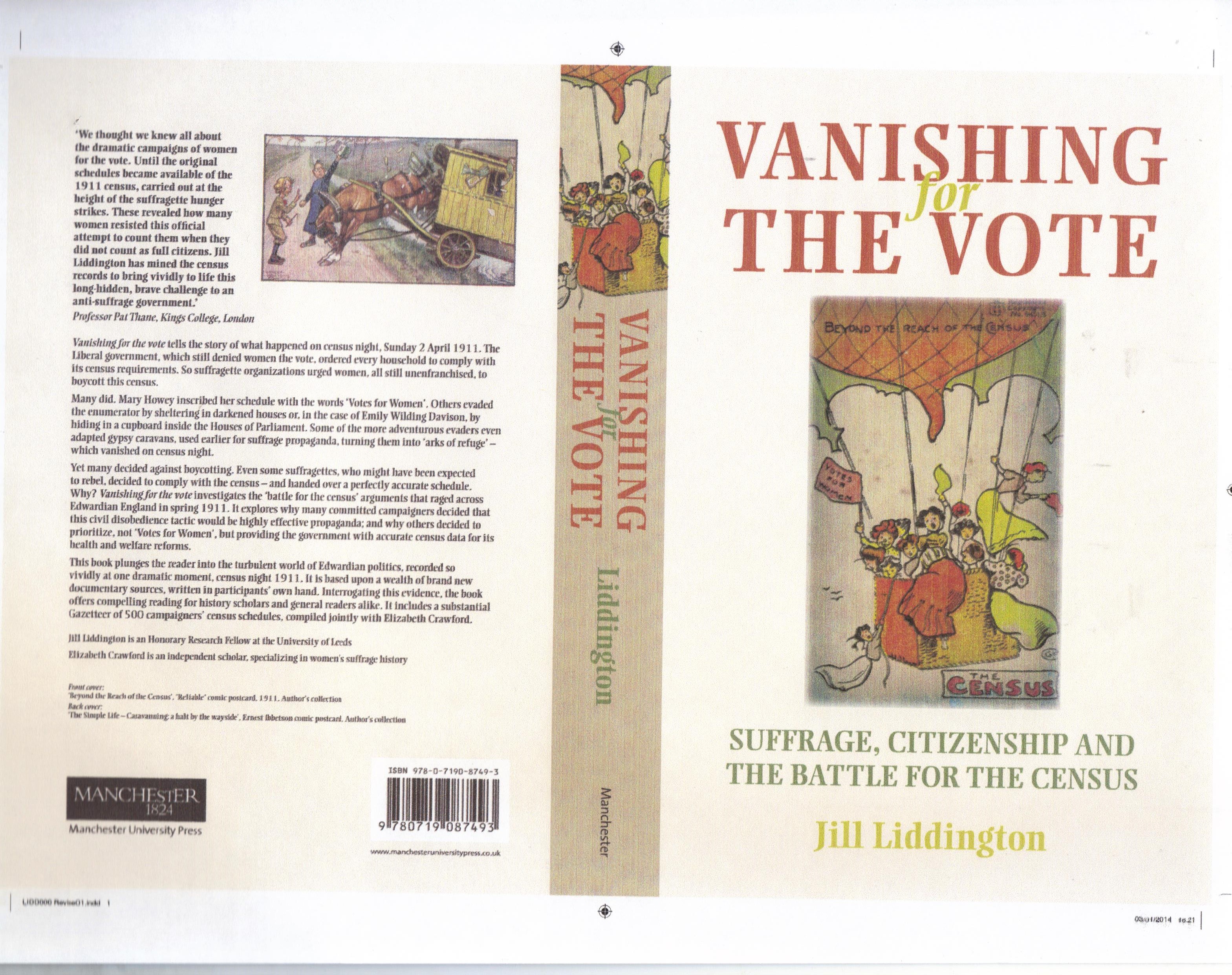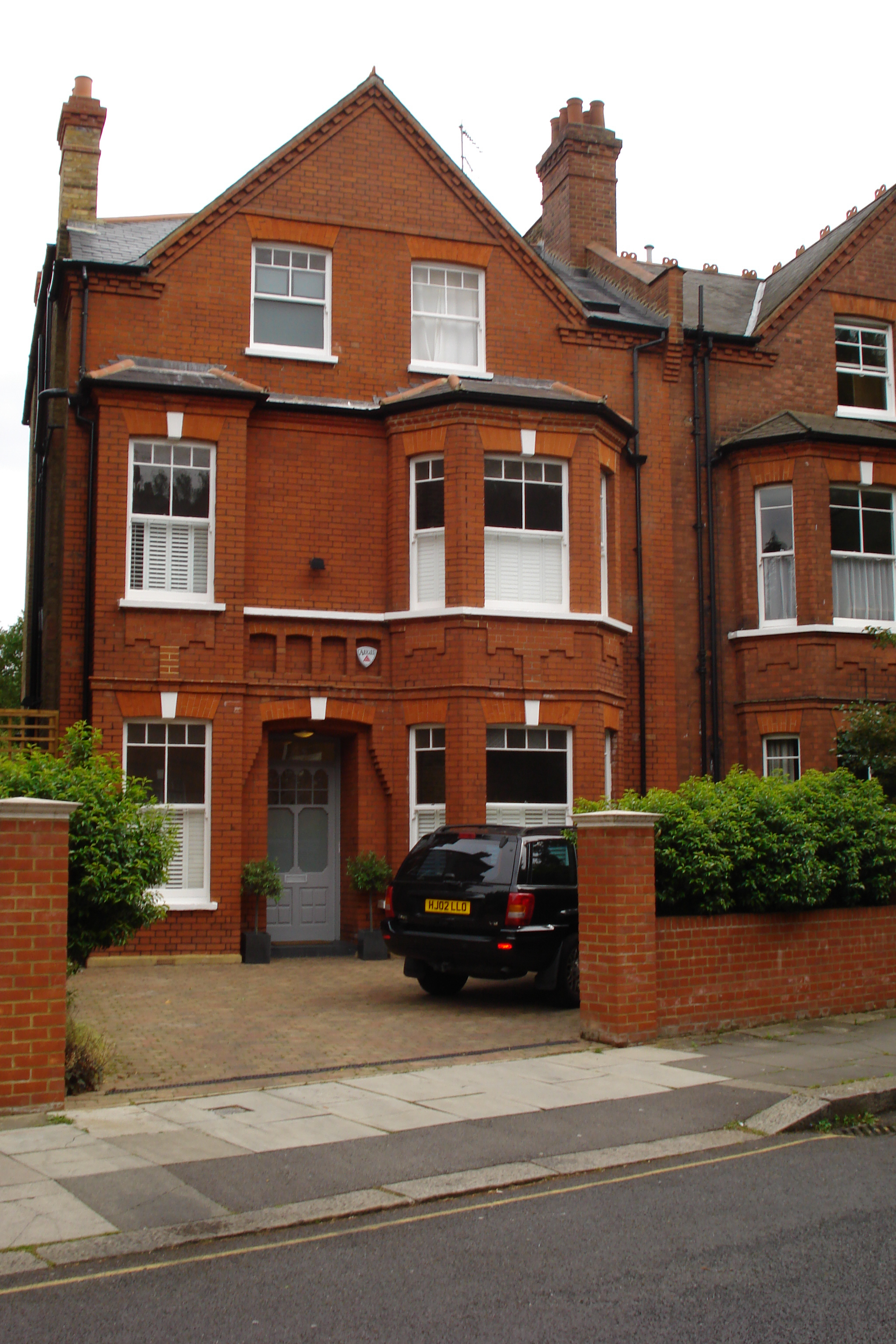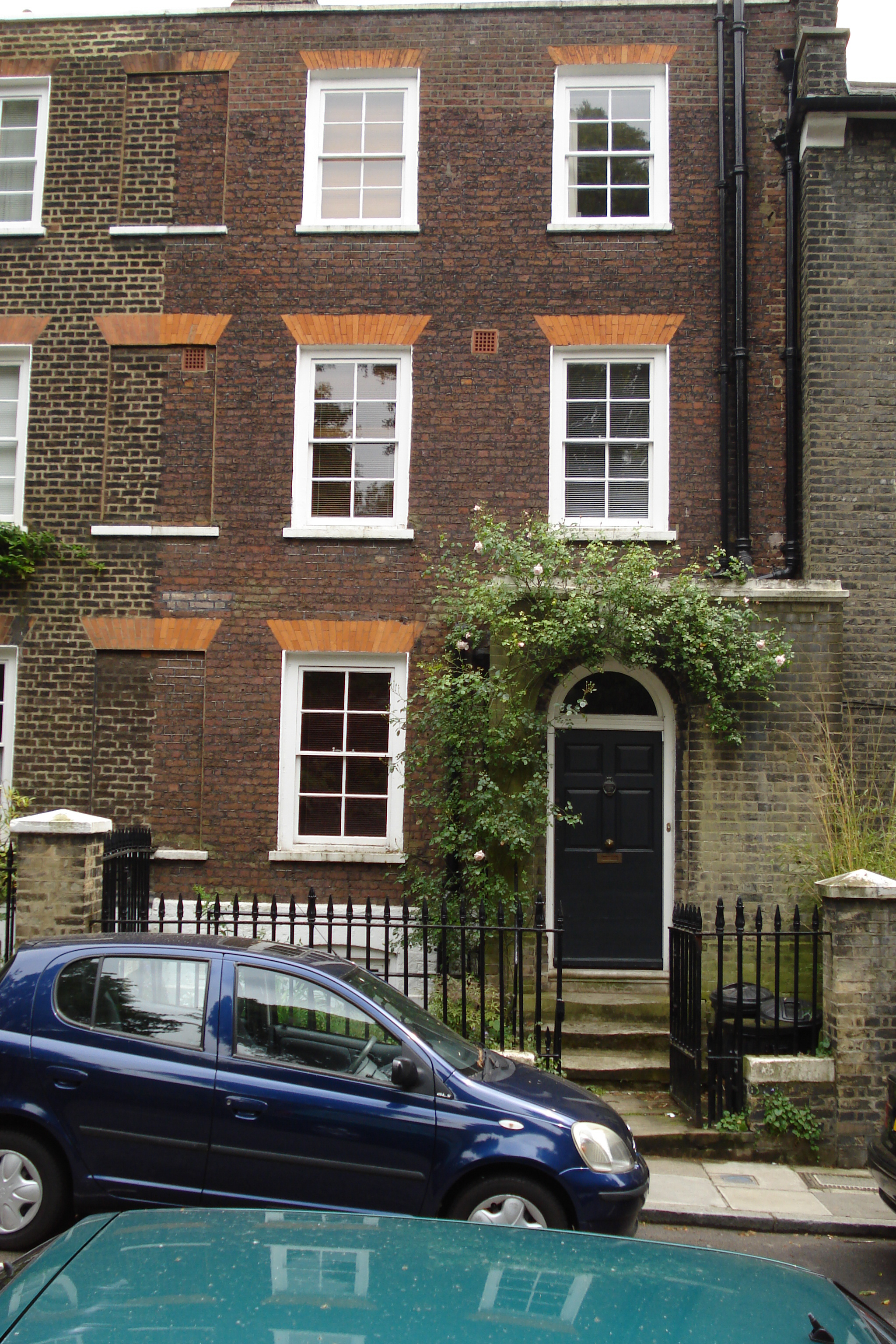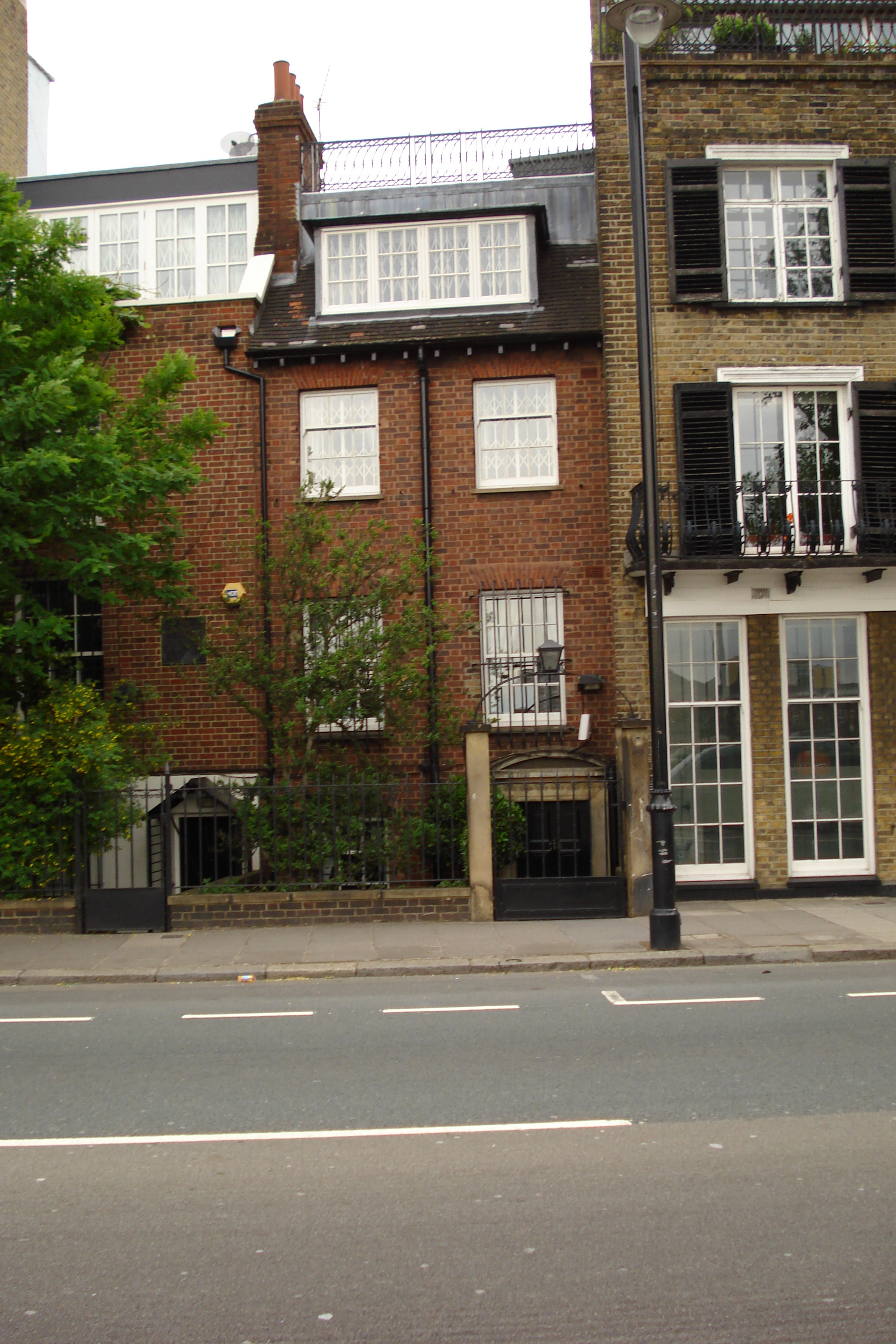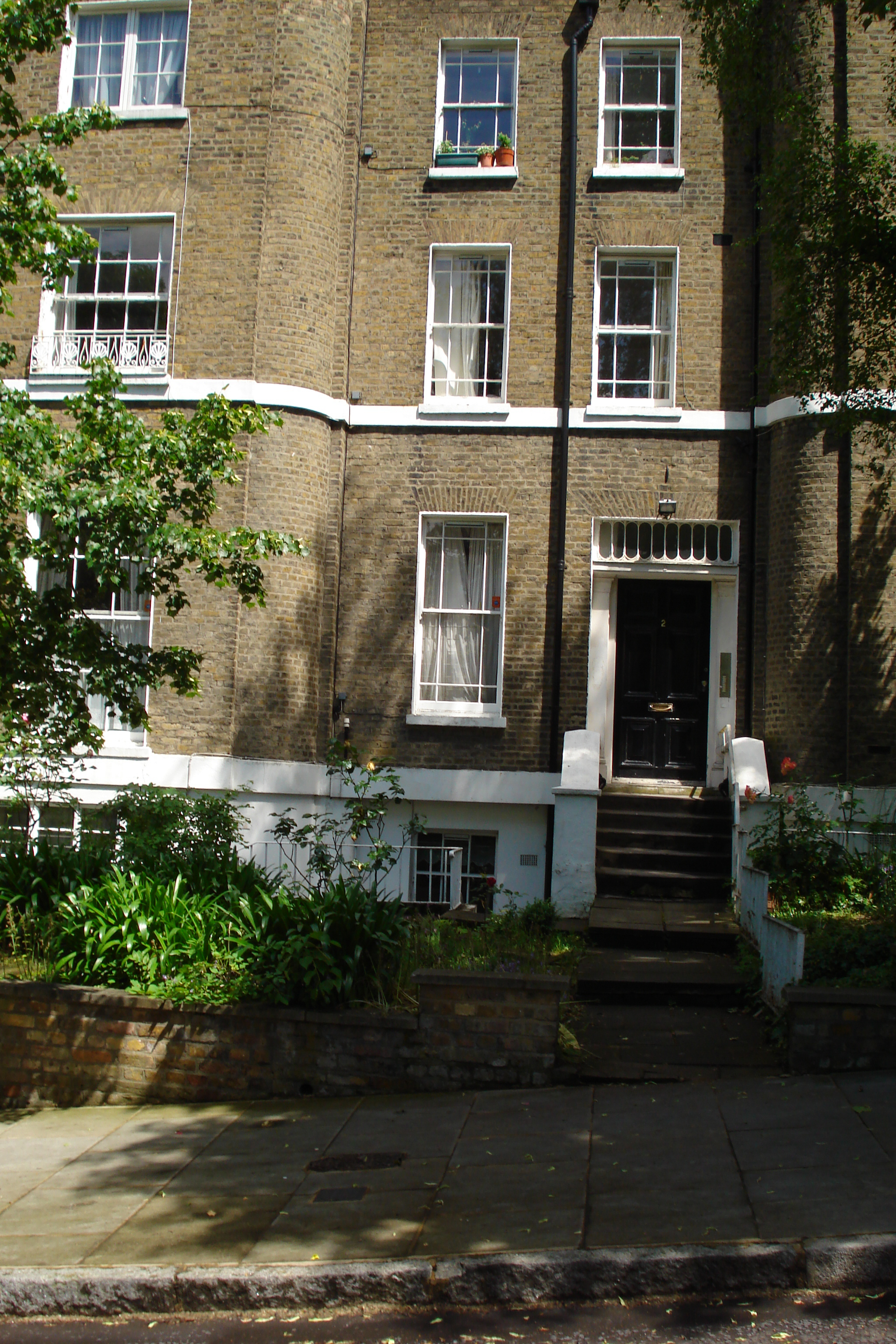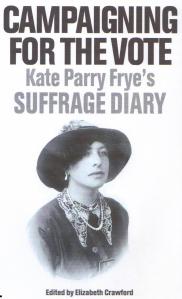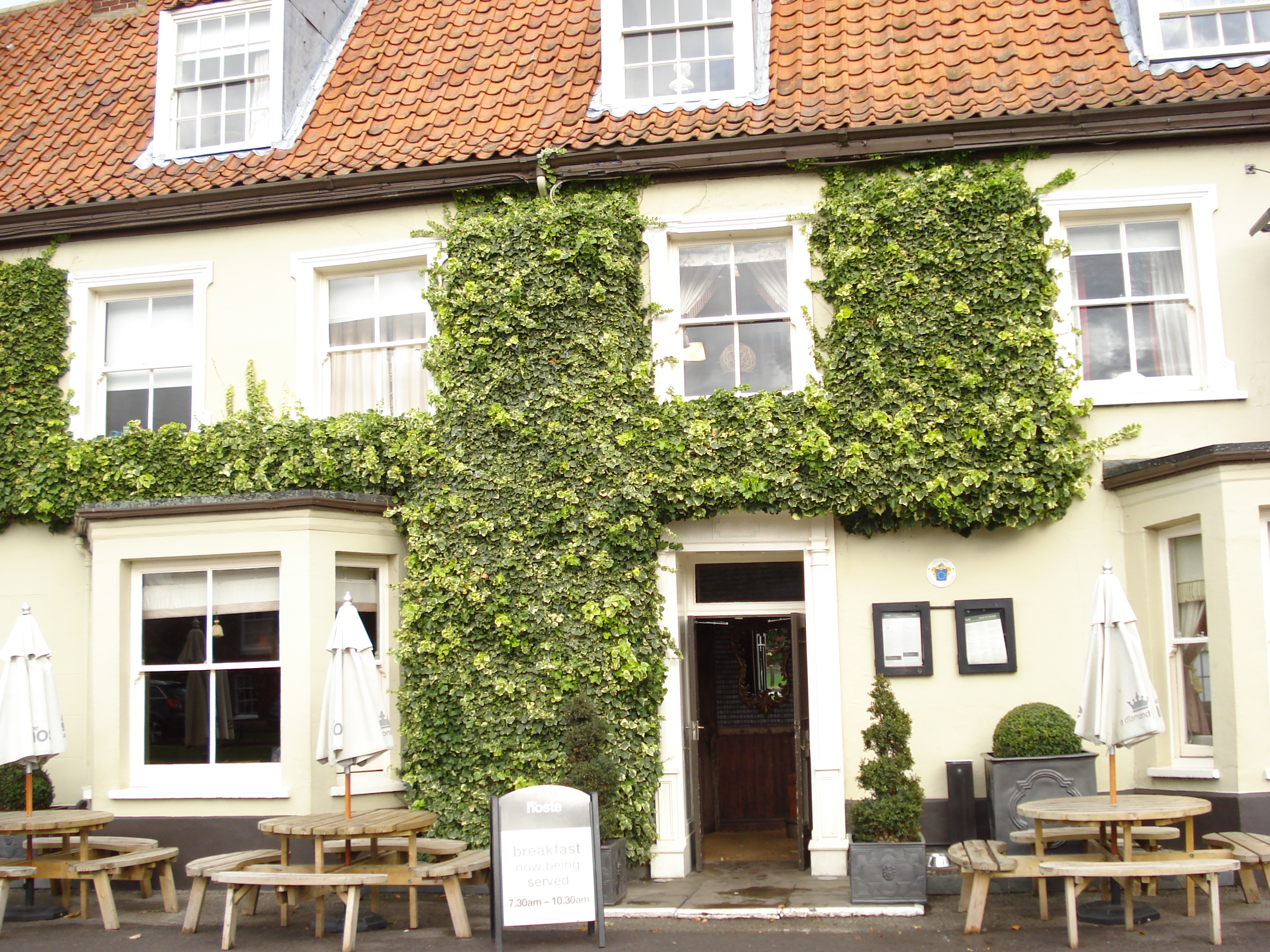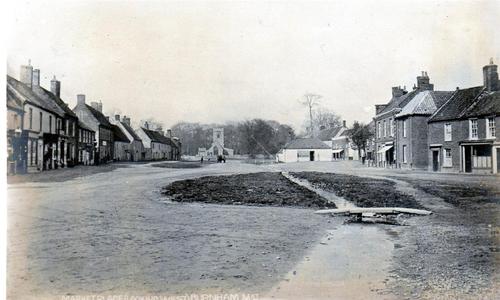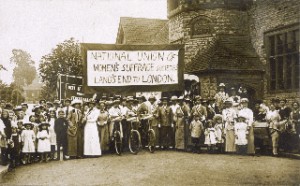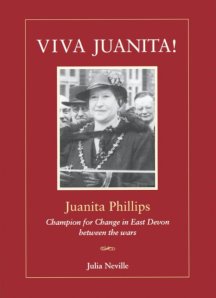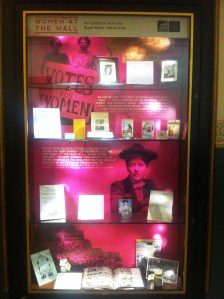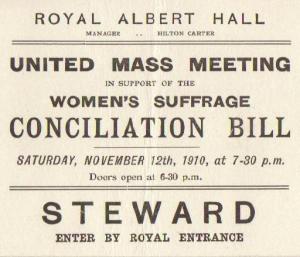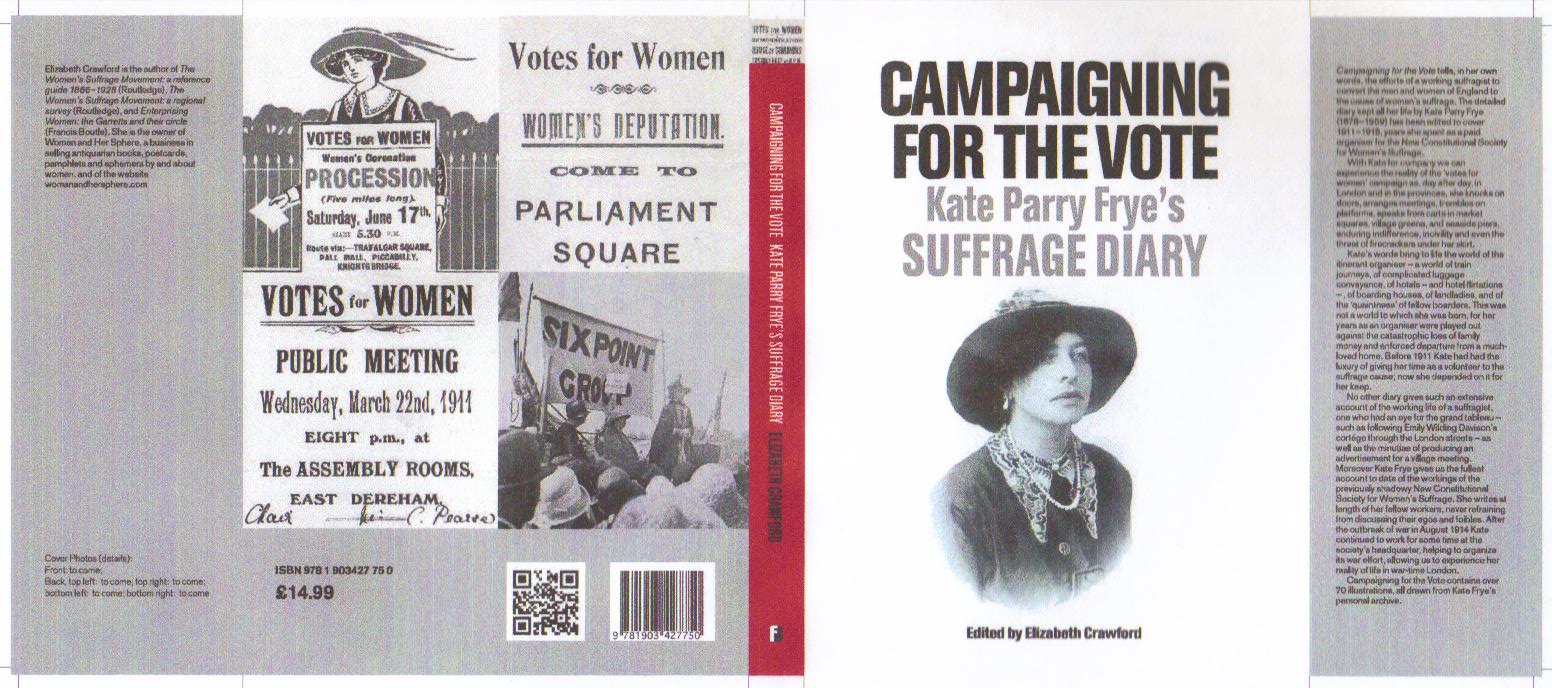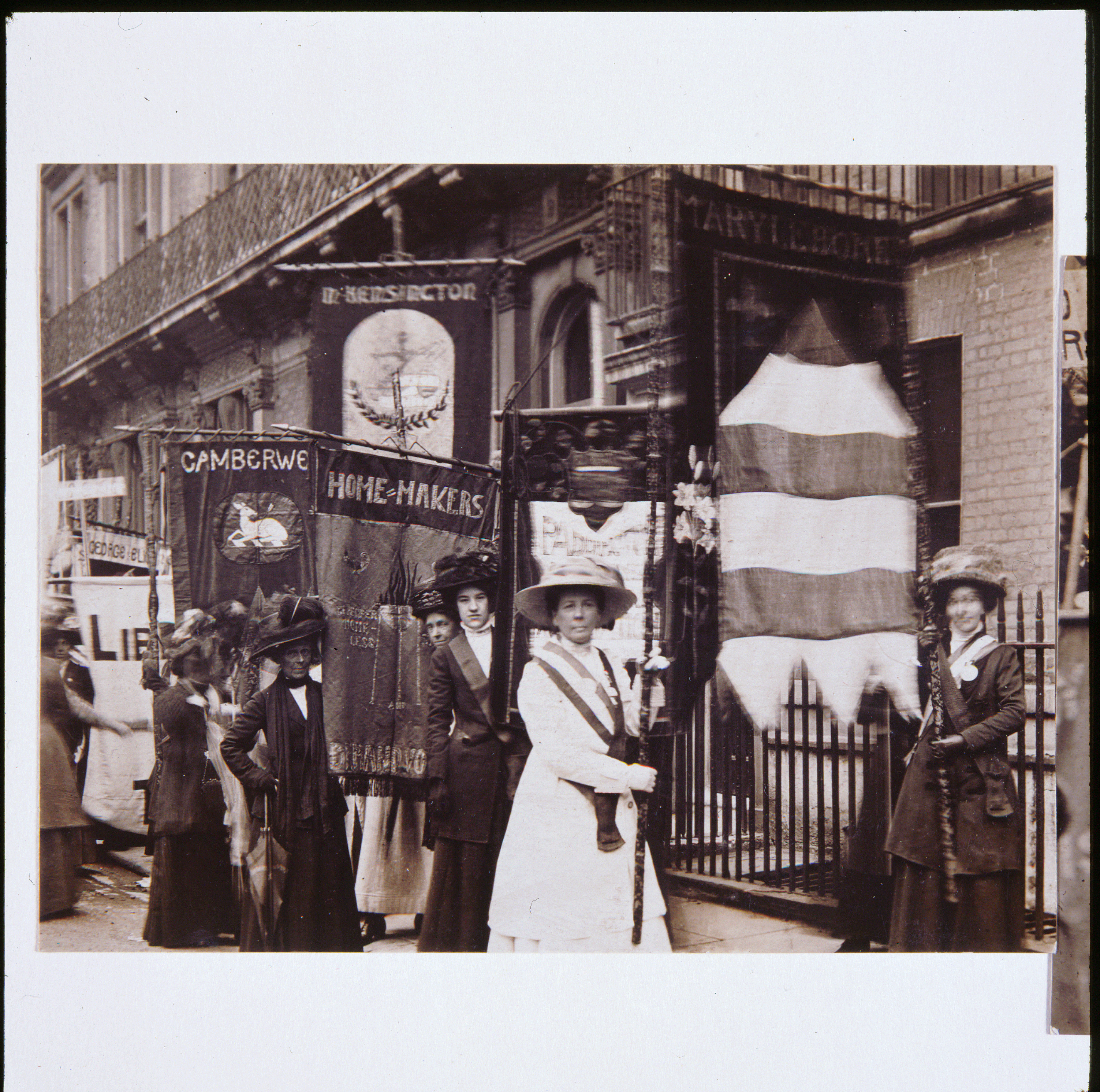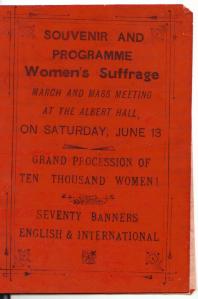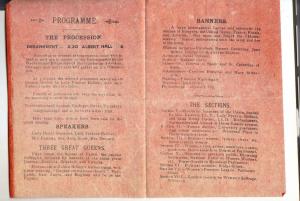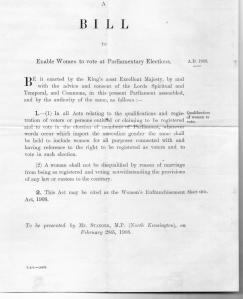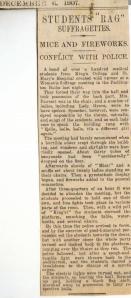Posts Tagged NUWSS
Collecting Suffrage: Photograph of Mrs Fawcett, 1890
Posted by womanandhersphere in Collecting Suffrage on September 3, 2020
Today I offer you a studio photograph of Millicent Garrett Fawcett by W & D Downey. Published by Cassell & Co, 1890. She was 43 years old and had already been a leading light of the women’s suffrage movement for over 20 years.
A very good image – mounted. Suitable for framing. £40 + VAT in UK & EU.
In the past I have been concerned about the low profile afforded popularly to Mrs Fawcett. Indeed, in 2013 I wrote a post on the subject: Make Millicent Fawcett Visible.
And in 2016 when there was a suggestion that there should be a statue of a ‘suffragette’ in Parliament Square I did point out that there was already one nearby to Mrs Pankhurst (which I was also determined would not be moved) and one, so often forgotten, to the suffragette movement in general, just down Victoria Street in Christchurch Gardens. That resulted in another post – on Suffragette Statues.
As we all know, the idea of a ‘suffragette’ statue in Parliament Square morphed, thanks to input from Sam Smethers and the Fawcett Society, into the already well-loved statue of Mrs Fawcett. So that she is now indeed publicly visible.
Yesterday’s photograph of Mrs Pankhurst proved very popular, but if you would like demonstrate your loyalty to Mrs Fawcett, here is an excellent opportunity to acquire a photograph of her with which to adorn your desk or wall.
Do email me if you’re interested in buying. elizabeth.crawford2017@outlook.com
Kate Frye’s Suffrage Diary: The Mud March, 9 February 1907
Posted by womanandhersphere in Kate Frye's suffrage diary on November 21, 2012
Kate Frye had first joined a suffrage society in the spring of 1906. Her choice was the Central Society for Women’s Suffrage (later renamed the London Society for Women’s Suffrage) – a constituent society of the National Union of Women’s Suffrage Societies Interest in the long-running women’s suffrage campaign leapt ahead in the following few months and in February 1907 the NUWSS staged the first open-air suffrage spectacular – a march through the wintry, muddy London streets. For obvious reasons this became known as the ‘Mud March’. Kate’s estimate of 3000 participants accords with later reports.
Saturday 9 February 1907 [25 Arundel Gardens, North Kensington]
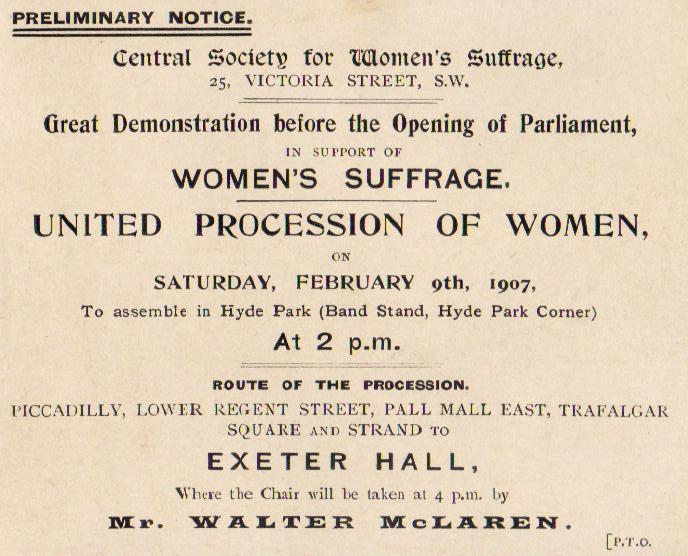 In bed for breakfast – and what was my utter disgust – and disappointment – to hear the torrents of rain – and there was not a shadow of its coming last night – it was bitterly cold. As it was so heavy I hoped it would stop – but it went on and on into a fine heavy drizzle. They said I should be mad to go in the procession and though I knew I must – I went out at 12.30 taking Mickie a walk and sent a telegram to Alexandra Wright telling her the rain prevented my joining them. I had arranged to be at their house at 1 o’clock and go with them to Hyde Park. We all had lunch. I knew I was going all the time – but couldn’t go. Off to wash my hands. 2 o’clock. ‘They will be just starting’, said I. Then as I washed I made up my mind I would go rain or no rain and – lo – the rain had ceased. I prepared a plan to Agnes. She too knew she was to be of it – both flew upstairs and were out of the house before 2.15.
In bed for breakfast – and what was my utter disgust – and disappointment – to hear the torrents of rain – and there was not a shadow of its coming last night – it was bitterly cold. As it was so heavy I hoped it would stop – but it went on and on into a fine heavy drizzle. They said I should be mad to go in the procession and though I knew I must – I went out at 12.30 taking Mickie a walk and sent a telegram to Alexandra Wright telling her the rain prevented my joining them. I had arranged to be at their house at 1 o’clock and go with them to Hyde Park. We all had lunch. I knew I was going all the time – but couldn’t go. Off to wash my hands. 2 o’clock. ‘They will be just starting’, said I. Then as I washed I made up my mind I would go rain or no rain and – lo – the rain had ceased. I prepared a plan to Agnes. She too knew she was to be of it – both flew upstairs and were out of the house before 2.15.
We tore to Notting Hill Gate – meaning to go the quickest way. No motor bus – so we tore for the train – it came in as I started to race down. In we scrambled – had to change at South Kensington much to our disgust – but we were not kept long. We flew out at Charing Cross and up Villiers Street. No sign of the Procession of Women Suffragists in the Strand. They were timed to leave Hyde Park at 2 o’clock so I had to pluck up my courage and ask a policeman. No, they had not passed. So, knowing the route, we flew up as far as Piccadilly Circus and there in about 2 minutes we heard strains of a band and waited, anxious and expectant. The crowd began to gather and we were nearly swept away by the first part – a swarm of roughs with the band – but the procession itself came – passed along dignified and really impressive. It was a sight I wouldn’t have missed for anything – and I was glad to have the opportunity of seeing it as well as taking part in it.
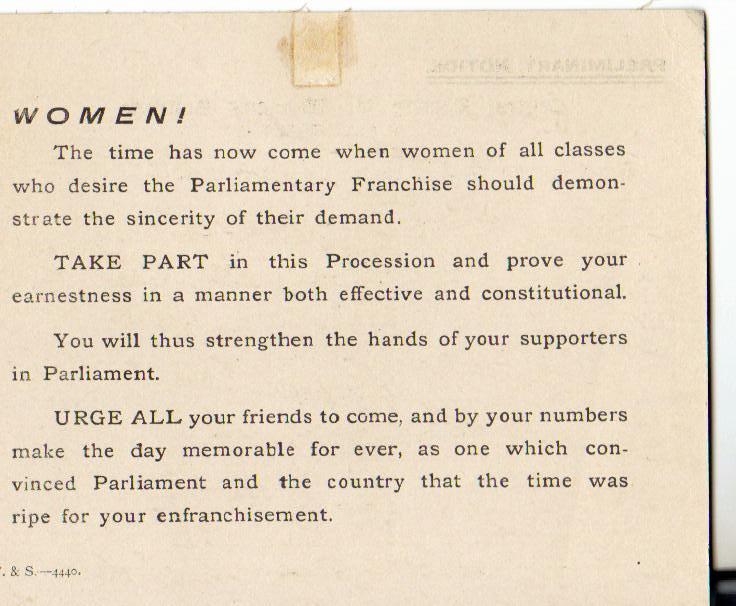 We stood right in front so as not to miss our contingent – and I asked if they knew where it was. Miss Gore Booth said it was coming and we were fearfully excited and I was so anxious not to miss our lot. I shrieked out when I saw Miss Doake’s red head in the distance and we dashed up to them and asked if we could join in. Alexandra carried our banner. Mrs Wright said come along here – it felt like boarding an express train but I suppose it was a quite simple rally though I cannot look back on it as that – but we were so excited and so anxious not to miss them. We walked three abreast – Miss Doake, Agnes and I – I was on the kerb side – behind us Gladys [Wright], Miss Ellis and Mrs Doake. North Kensington was not very well represented but I really do not know who else of us was there.
We stood right in front so as not to miss our contingent – and I asked if they knew where it was. Miss Gore Booth said it was coming and we were fearfully excited and I was so anxious not to miss our lot. I shrieked out when I saw Miss Doake’s red head in the distance and we dashed up to them and asked if we could join in. Alexandra carried our banner. Mrs Wright said come along here – it felt like boarding an express train but I suppose it was a quite simple rally though I cannot look back on it as that – but we were so excited and so anxious not to miss them. We walked three abreast – Miss Doake, Agnes and I – I was on the kerb side – behind us Gladys [Wright], Miss Ellis and Mrs Doake. North Kensington was not very well represented but I really do not know who else of us was there.
Then the real excitement started. The crowds to see us – the man in the street – the men in the Clubs, the people standing outside the Carlton – interested – surprised for the most part – not much joking at our expense and no roughness. The policemen were splendid and all the traffic was stopped our way. We were an imposing spectacle all with badges – each section under its own banners. Ours got broken, poor thing, unfortunately, and caused remarks. I felt like a martyr of old and walked proudly along. I would not jest with the crowd – though we had some jokes with ourselves. It did seem an extraordinary walk and it took some time as we went very slowly occasionally when we got congested – but we went in one long unbroken procession. There were 3000 about I believe. At the end came ever so many carriages and motor cars – but of course we did not see them. Lots of people we knew drove.
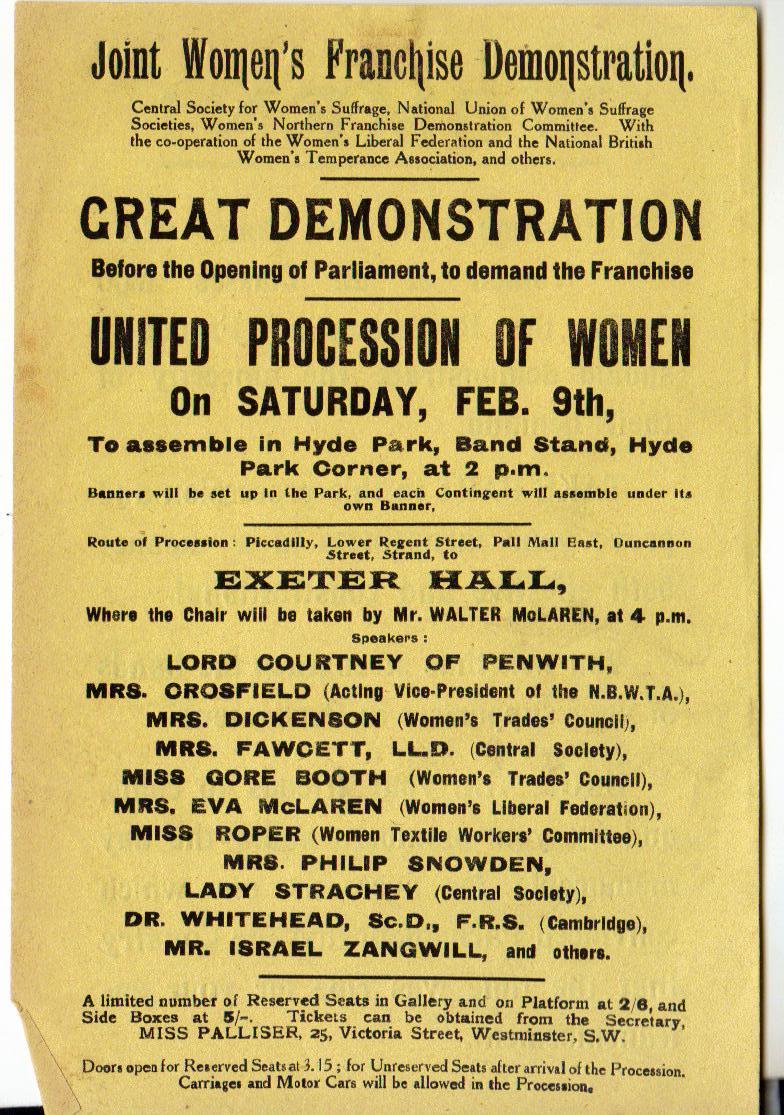 Flyer advertising the NUWSS ‘Mud March’
Flyer advertising the NUWSS ‘Mud March’Up the Strand it was a great crowd watching – some of the remarks were most amusing. ‘Here comes the class’ and two quite smart men standing by the kerb ‘I say look at those nice girls – positively disgraceful I call it.’ Then ‘Ginger hair – dark hair – and fair hair’ ‘Oh! What nice girls’ to Miss Doake, Agnes and I. Several asked if we had brought our sweethearts and made remarks to express their surprise at our special little band. ‘All the prizes in this lot’ etc. The mud was awful. Agnes and I wore galoshes so our feet were alright but we got dreadfully splashed. It was quite a business turning into the Exeter Hall. A band was playing merrily all the time – the one which had led the procession – and there was one not far off us. Three altogether, I was told.
 Exeter Hall in 1905
Exeter Hall in 1905We got good seats and of course had to wait some time before the meeting started – it was just after 4 pm when it did – but there was a ladies’ orchestra performing and playing very well and a lady at the organ in between whiles. The meeting was splendid. Mr Walter McLaren in the Chair and Israel Zangwill as chief speaker – he was so splendid and most witty. Miss Gore Booth – Mrs Fawcett – Mrs Eva McLaren – Lady Strachey and several other ladies spoke and Keir Hardie made an excellent speech. It was altogether a wonderful and memorable afternoon – and felt we were making history – but after all I don’t know, I am sure, what will come of it. The MPs seem to have cheated and thoroughly ‘had’ us all over it. They wanted the Liberal Women’s help to get into the House and now they don’t care two straws or they are frightened of us. We walked up to Tottenham Court Road and came home by bus. It was nearly 7 o’clock when we got in. .. I felt bitterly tired all the evening after the excitement.
Dramatis Personae for this entry
Agnes, Kate’s elder sister
Mickie, Kate’s beloved dog
Alexandra and her sister, Gladys, lived at 10 Linden Gardens. It was under their influence that Kate had joined the London Society for Women’s Suffrage.
Violette Mary Doake (b 1888) her parents were Irish, which may account for the red hair. Her mother, Mary Elizabeth Doake, was also a suffragist. Her father, Richard Baxter Doake, described in the 1911 census as a ‘tea planter’, was elected as a Progressive party member in 1892 to the LCC seat relinquished by Frederick Frye. In 1901 the Doakes lived at 24 Stanley Gardens, close to the Fryes. By 1911 they had moved to 25 Ladbroke Gardens.
Walter McLaren and his wife, Eva were members of a family of long-standing supporters of women’s suffrage. He had been Liberal MP for Crewe in the 1890s and regained the seat in 1910.
Israel Zangwill, Jewish novelist and very effective writer and speaker in support of women’s suffrage
Lady Strachey had worked for women’s suffrage since the 1860s. She remarked that after this march she had to boil her skirt.
Keir Hardie, first Independent Labour Party MP. He had strongly supported a motion in favour of women’s suffrage at the Labour party conference on 26 January
Campaigning for the Vote: Kate Parry Frye’s Suffrage Diary edited by Elizabeth Crawford
For a full description of the book click here
Wrap-around paper covers, 226 pp, over 70 illustrations, all from Kate Frye’s personal archive.
ISBN 978 1903427 75 0
Copies available from Francis Boutle Publishers, or from Elizabeth Crawford – elizabeth.crawford2017@outlook.com (£14.99), or from all good bookshops.
- Campaigning for the Vote– Front and back cover of wrappers
You can also listen here to a Radio 4 programme as Anne McElvoy and I follow the route of the ‘Mud March’.
Copyright
Kate Frye’s Suffrage Diary: Banner Bearer For The 13 June 1908 Procession
Posted by womanandhersphere in Kate Frye's suffrage diary on October 30, 2012
Asquith became prime minister in April 1908. In response to his claim that he needed proof that large numbers of women really wanted the vote, the National Union of Women’s Suffrage Societies – and the WSPU – decided to mount a spectacular summer procession through London. The magnificent banners, such as that for North Kensington, carried some of the way by Kate, were the work of the Artists’ Suffrage League, in particular of Mary Lowndes.

Mary Lowndes’ design for the North Kensington banner – with swatches of suggested material (courtesy of the Women’s Library@LSE)
The design of the North Kensington banner, held in the Women’s Library, can be seen
The banner itself was photographed during the course of the 13 June 1908 procession. ‘North Kensington’ is being held high; unfortunately the ‘Home Makers’ obscure the North Kensington banner bearers. Was one of them Kate?
Saturday June 13th 1908 [Bourne End]
The great day dawned at last looking rather threatening – dull and very windy. I did not know quite what to wear but chanced the day wisely as it fell out and wore my best cream linen skirt and embroidery blouse and made myself look nice. I took a coat with me. Down to breakfast, had a chat to Agnes, who was very disappointed not to be going but really she was not up to it and it would have been no use attempting such an exacting and arduous day. It took it out of me. I was ‘going’ inside all day. Went up to London by the 9.53 train wearing my decorations – my ‘Votes for Women’ disk – my National Union Suffrage brooch and my red and white ribbon – the one that went through that exciting evening at the Paddington Baths. I wore them all day and it was most amusing to see the looks given to them. I went shopping in Whiteleys. Then a bus to Bond Street, walked through Burlington and along to the Strand – there I began to see some of my fellow marchers and the Lyons where I lunched was crowded with them – every one agog, of course, to see us.
Then I went to the A.A. [the Actors’ Association] tidied myself up and went upstairs. Quite an excitement there to see me and I found Eve Erskine wavering as to whether or not she should join the march. She rather aggravated me by some of the things she said about it. Then she is so tactless and really doesn’t know. It was from her I learned that there would be a contingent of Actresses headed by Gertrude Kingston, Lillah McCarthy and Mrs Pat [Campbell] and I must own I did feel deadly disappointed not to be going with them. I am sure Miss Gladys [Wright] kept it from me on purpose as she knew how eager I was to get the theatrical people to go and I said how I should like to march with them. So for that reason she did not send me a plan of the order of procession, I feel sure. Not quite straight because, any way, if she had said they really needed my help in Kensington I should have gone. But she and Alexandra went with the graduates and they wanted me responsible for N[orth] Kensington. There was really no-one else. Mrs Wright could not have carried the Banner or any of the small women if they could have it would not have looked right and comfortable. So I was offered up as a sacrifice. I think it was only right a Frye should be the Banner Bearer for North Kensington and I loved to do it and felt very proud but at first I must own to feeling a bit sick over it. I had a few words with Mr Halliwell Hobbs, who was crimson in the face with annoyance about it all. I said ‘will you shake hands though I am going to carry a banner.’ He simply could not bear himself – it so upset him to see my decorations. Eve walked or rather ran – we got so excited seeing the crowds – to the Embankment and there I lost her. I suppose she found her Block and marched with them for I saw her no more.
The crowds and the excitement was terrific and I really didn’t know how I should find my banner in it all. First I saw Miss Corbett who gave me a plan. Eve had one so I am sure Gladys ought to have sent her Banner Bearer one. And then I found I should be Block 8 – and a nice scamper I had right up Whitehall before I came to my place. Whitehall was quieter, but the crowds on the Embankment were terrific. At last I came to the Block for the London Society and found a messenger boy with the little White and Red Banners we had before. He gave it up to me on hearing my name and I was left alone. As I got there soon after 2 o’clock it was alright but I longed for some friendly face. I had had a glance at some of the Banners as I sped along – they were lovely. At last one or two women whose faces I knew turned up and then three girls with a huge and beautiful banner – one of the Artist League ones – the one Gladys meant me to carry and take the responsibility of. They were in too much of a hurry, the girls, to be off to tell me how to manage it and I had my flapping coat and the wind was terrific. I got one of the others to hold the little one till Mrs Wright and a lot of other people came. Then a tall girl carried the little one at the back of the Kensington Block. Some one very kindly carried my coat and I got the frog fixed round the banner more comfortably. Miss Madge Porter carried one cord, Miss Meyer the other.
We were immediately behind the Holborn section and Lady Grove’s pretty daughters carried that Banner – a huge one – but, lucky beggars, they had two poles to support it. Mine was fearfully heavy, especially in the wind – but I was given a gift with it I think. It was a beauty nauge cloth – brown and yellow silk and cloth of gold. Mrs Percy Harris was just behind. She had to fall out early as she went very strange and there were lots of people I know by sight. We were quite a smart collection – all in our best summer attire. The stewards marshalled us six abreast behind the Banner which had to stand out. The whole thing was most wonderfully organised.
Before we moved off John [her fiance] arrived on the scene with Mr Andrews [a friend] and was most proud to shake hands with me and I think the whole thing quite converted him. They went off to see the Banners, then took up their stand in Trafalgar Square and watched us go. John watched it over an hour. He saw me but I didn’t see him. He says I was laughing away and looked to be enjoying myself. Some of the remarks were enough to make one laugh. I saw Mr Dickenson [the M.P.] go past and G.B. Shaw while I was waiting and there were all sorts of weird and curious men – one dressed up like a Jack in the Box to represent Adam, I think – but I couldn’t make him out.
Before 2.30 we were off to the strains of a Band and marshalled in order and we reached one side of the Embankment. We were given 2.30 to assemble – so those who turned up then must have had a difficulty in finding us. It took some time – then there was half an hour’s wait in line – then we began to manoeuvre about – the police directed us. I don’t really know what we did but we turned back round the road while a stream passed us the other way then round me went again over to the side of the trams which made some of them nervous. The trams were packed with people to see us. Then a long wait again – 3.30 I should say before we moved off – and then a very slow procession up Northumberland Avenue – halts of five minutes at a time, it seemed. We were in the middle of two Bands so we were never dull and sometimes with the clamour of the two together it was terrific but the marches helped me along and we three kept step. Oh the crowds – packed like sardines the other side of Piccadilly – some of the roughest of the rough on the Embankment but for the most part quite friendly and polite. There seemed so few policemen in comparison that if the crowd had liked to be disagreeable it would have been awful. The clubs and hotel windows and steps were thronged. Most of the people seemed interested – some were laughing. We only had passage enough just to pass along till we got to the Square then our pace mended till it grew terrific and had almost to run to keep up and going up Waterloo Place was a great strain. From the bottom we could see the Banners winding up and up.
We were about 10,000 with 70 Artist League banners – lots of others and hundreds of Bannerettes shimmering in the wind. For the most part after Piccadilly the crowd was quite a different class and quiet and respectful – many men raised their hats to us and ladies clapped their hands – lots of children? were in the crowd and ‘Mother’ made one clap his hands at me. One nice old clergyman bared his silver locks to each Banner Bearer. Of course it was a very different thing from last year [ie the February ‘Mud March’] – gigantic in comparison and, as for the crowds, I had never seen anything like them except at Royal Weddings etc and a good long route we had. Up Northumberland Avenue, Lower Regent Street, Piccadilly, Knightsbridge, Exhibition Road to the Albert Hall. The first part of them must have been in the hall soon after we left the Embankment. I was in the last section – No 8, the London Society – but I could not see our end and after us came all the motor cars and carriages. The Social and Political Union people had a four in hand and were up and down distributing notices of their great demonstration on Sunday week in Hyde Park. The Graduates and Doctors looked simply lovely – I am sure they must have got some cheering ‘Well’ I heard one man say, ‘what I like about them is there isn’t one with a bit of powder on’.
‘Lucky you have dropped your garter’ ‘Have you mended the socks’ Have you washed the baby’ and such remarks as those were rife and, of course, lots of comments on one’s personal appearance – rather painful some of them –‘Oh look at this nice girl’ ‘isn’t she a beauty’ etc but really most of the people were quite kind and sympathetic. I think it must have been rather a stirring sight – it seemed to me ‘magnificent’. I felt it was moving the people. I heard people say in awestruck tones ‘I don’t believe it will ever end’ Miss Meyer took the Banner from me in Piccadilly and carried it to the end – she hadn’t had all that tiring first part and the long waits and she was strong and capable. I must say I was getting a bit done with it but I would have liked it again later only she seemed quite happy and I did not like to take it from her. Gladys had written to say she would help me with it. She took it in the hall and sat with it also.
The approach to the [Albert] hall was very slow again – but the pace all along Piccadilly had been tremendous. I think we must have been catching the first lot up where it had been broken at Trafalgar Square for the traffic. I got in the hall about 5.10 and they started the meeting just as I sank down. I must own to feeling completely done when I left the Banner. I got cramp in both feet at once and felt 1,000 but I dashed into the hall found the seat in my box with the Wrights and Alexandra, like an angel, got me a cup of tea. She, Gladys and another girl looking most awfully charming in cap and gown. Mrs Stanbury was there and Mrs Lambert and several people I knew. I had to keep my eye on the clock but I heard Lady Henry Somerset, Dr Anna Shaw, Mrs Fawcett and [then] Miss Sterling present the Bouquet to Mrs Fawcett – then the procession of Bouquets till the platform looked like a garden. They were just singing ‘For she’s a jolly good fellow’ when I came out. I got a cab, still very lame, and drove to Paddington. There I met John and Mrs Harris and the train was looking out for me – so we travelled down together, talking all the way…
The Actors Association, a club to which both Kate and John belonged, was at 10 King Street, Covent. Garden.
Halliwell Hobbs, 30-year-old actor, was clearly a young fogey.
Margery Corbett (1882-1981- later Dame Margery Corbett-Ashby) was the daughter of a Liberal MP. At this time she was secretary of the NUWSS
Lady Henry Somerset (1851-1921) was a wealthy philanthropist and leader of the temperance movement.
Mrs Percy Harris, née Marguerite Frieda Bloxam, wife of Percy Harris (later Sir Percy Harris), who became a Liberal MP in 1916, lived in Bourne End.
Anna Howard Shaw (1847-1919) US physician, temperance reformer and, at this time, leader of the National American Woman Suffrage Association.
Frances Sterling (1869-1943) joint honorary secretary of the NUWSS.
Campaigning for the Vote: Kate Parry Frye’s Suffrage Diary edited by Elizabeth Crawford
For a full description of the book click here
Wrap-around paper covers, 226 pp, over 70 illustrations, all drawn from Kate Frye’s personal archive.
ISBN 978 1903427 75 0
Copies available from Francis Boutle Publishers, or from Elizabeth Crawford – e.crawford@sphere20.freeserve.co.uk (£14.99 +UK postage £3. Please ask for international postage cost), or from all good bookshops. In stock at London Review of Books Bookshop, Foyles, National Archives Bookshop.
Kate Frye’s Suffrage Diary: Spring 1908 – Suffrage Hope – WSPU in Albert Hall ‘a little too theatrical but very wonderful’
Posted by womanandhersphere in Kate Frye's suffrage diary on September 26, 2012
Another extract from Kate Frye’s manuscript diary. An edited edition of later entries (from 1911), recording her work as a suffrage organiser, is published as Campaigning for the Vote: Kate Parry Frye’s suffrage diary.
Kate’s MP, Henry Yorke Stanger, was the promoter of the current Enfranchisement Bill – the latest in the long line that stretched back through the latter half of the 19th century. Despite, as Kate describes, the bill passing its second reading, the government eventually refused to grant facilities to further the debate. However, that blow was yet to come as Kate records in these entries details of the suffrage meetings she attended in February and March 1908. She had the knack of always being present on the great occasions – and on 19 March was in the Albert Hall to witness the rousing – and profitable – reception given to Mrs Pankhurst on her release from prison.
Dramatis personae:
Miss Harriet Cockle, was 37 years old, an Australian woman of independent means, lving at 34 de Vere gardens, Kensington.
Mrs Philip Snowden – Ethel Snowden (1880-1951) wife of the ILP politician, Philip Snowden.
Mrs Clara Rackham (1875-1966) was regarded as on the the NUWSS’s best speakers. In 1910 she became president of the NUWSS’s Eastern Federation, was founder of the Cambridge branch of the Women’s Co-operative Guild, and was sister-in-law to Arthur Rackham, the book illustrator.
Margery Corbett (1882-1981- later Dame Margery Corbett-Ashby) was the daughter of a Liberal MP. At this time she was secretary of the NUWSS.
Mrs Fanny Haddelsey,wife of a solicitor, lived at 30 St James’s Square, Holland Park.
Mrs Stanbury had been an organiser for NUWSS as far back as 1890s.
Tuesday February 25th 1908 [London-25 Arundel Gardens]
We got home at 5.15 and had tea. Then I did my hair and tidied myself and Agnes and I ate hot fish at 6.30 and left soon after in a downpour of rain for the Kensington Town Hall – we did get wet walking to the bus and afterwards. We got there at 7 o’clock to steward – the doors were opening at 7.30 and the meeting started at 8.15. I was stewarding in the hall downstairs and missed my bag – purse with 6/- and latch Key etc – very early in the evening which rather spoilt the evening for me as I felt sure it had been stolen. It was a South Kensington Committee of the London Society for Woman’s Suffrage and we were stewarding for Miss Cockle. It was a good meeting but not crowded but, then, what a night. Miss Bertha Mason in the Chair. The speech of the evening was Mrs Philip Snowdon, who was great, and Mrs Rackham, who spoke well. The men did not do after them and poor Mr Stanger seemed quite worn out and quoted so much poetry he made me laugh. Daddie had honoured us with his presence for a little time and had sat on the platform – so I feel he has quite committed himself now and will have no right to go back on us. We were not in till 12.20 and then sat some time over our supper.
Wednesday February 26th 1908
Before I was up in the morning Mother came up in my room with my bag and purse and all quite safe. It had been found and the Hall Door Keeper had brought it. I was glad because of the Latch Key. Daddie generously had paid me the 6/- which I was able to return.
Friday February 28th 1908
Mr Stanger’s Woman’s Suffrage Bill has passed the second reading. I had to wait to see the Standard before going to my [cooking] class. That is very exciting and wonderful – but of course we have got this far already in past history. Oh! I would have liked to have been there.
MargWednesday March 11th 1908
To 25 Victoria Street and went to the 1st Speakers Class of the N.[ational] S.[ociety] of W.[omen’s] S.[uffrage]. I was very late getting there and there was no one I knew so I did not take any part in the proceedings and felt very frightened. But Alexandra Wright came in at the end and I spoke to Miss Margery Corbett and our instructoress, Mrs Brownlow. And then I came home with Alexandra from St James’s Park station to Notting Hilll Gate.
Thursday March 12th 1908
Mother went to a Lecture for the NKWLA [North Kensington Women’s Liberal Association] at the Club and Agnes and I started at 8 o’clock and walked to Mrs Haddesley [sic] for a drawing-room Suffrage Meeting at 8.30. Agnes and I stewarded and made ourselves generally useful. The Miss Porters were there and a girl who I saw at the Speakers’ Class on Wednesday. Alexandra was in the Chair and spoke beautifully – really she did. And Mrs Stanbury spoke. Mrs Corbett and Mrs George – all very good speakers. Mrs Stanbury was really great and there were a lot of questions and a lot of argument after, which made it exciting. It was a packed meeting but some of the people were stodgy. Miss Meade was there with a friend – her first appearance at anything of the kind she told us and she said it was all too much for her to take in all at once. The “class” girl walked with us to her home in HollandPark and we walked on home were not in till 11.45. I was awfully tired and glad of some supper and to get to bed.
Mrs Pankhurst had been arrested on 13 February as she led a deputation from the ‘Women’s Parliament’ in Caxton Hall to the House of Commons. She was released from her subsequent imprisonment on 19 March, going straight to the Albert Hall where the audience waiting to greet her donated £7000 to WSPU funds. Kate was there.
Thursday March 19th 1908
I had a letter in the morning from Miss Madge Porter offering me a seat at the Albert Hall for the evening and of course I was delighted….just before 7 o’clock I started for the Albert Hall. Walked to Notting Hill gate then took a bus. The meeting was not till 8 o’clock but Miss Porter had told me to be there by 7 o’clock. We had seats in the Balcony and it was a great strain to hear the speakers. It was a meeting of the National Women’s Social and Political Union – and Mrs Pankhurst, newly released from Prison with the other six was there, and she filled the chair that we had thought to see empty. It was an exciting meeting. The speakers were Miss Christabel Pankhurst, Mrs Pethick Lawrence, Miss Annie Kenney, Mrs Martel and the huge sums of money they collected. It was like magic the way it flowed in. It was all just a little too theatrical but very wonderful. Miss Annie Kenney interested me the most – she seems so “inspired” quite a second Joan of Arc. I was very pleased not to be missing so wonderful an evening and I think it very nice of Miss Porter to have thought of me. She is quite a nice girl of the modern but “girlie” sort – a Cheltenham girl and quite clever – but very like a lot of other girls. Coming out we met, strangely enough, Mrs Wright and Alexandra (Gladys was speaking at Peckham) and after saying good-bye to Miss Porter I walked home with them as far as Linden Gardens. Got in at 11.30 very tired indeed and glad of my supper. Mother was waiting up.
Campaigning for the Vote: Kate Parry Frye’s Suffrage Diary edited by Elizabeth Crawford
For a full description of the book click here
Wrap-around paper covers, 226 pp, over 70 illustrations, all drawn from Kate Frye’s personal archive.
ISBN 978 1903427 75 0
Copies available from Francis Boutle Publishers, or from Elizabeth Crawford – e.crawford@sphere20.freeserve.co.uk (£14.99 +UK postage £3. Please ask for international postage cost), or from all good bookshops. In stock at London Review of Books Bookshop, Foyles, National Archives Bookshop.
Kate Frye’s Diary: ‘Paddington Pandemonium’
Posted by womanandhersphere in Kate Frye's suffrage diary on August 23, 2012
In the following diary entry Kate describes the pandemonium that occurred at a December 1907 suffrage meeting organised by the North Kensington Local Committee of the Central Society for Women’s Suffrage – the non-militant London NUWSS society – chaired by Mrs Millicent Fawcett. From Kate’s account the main culprits were medical students from nearby St Mary’s Hospital and from University College Hospital in Bloomsbury, such student having had, through the ages, a reputation for unruly behaviour. From Kate’s observation, the stories of stinkbombs and the release of mice, specifically intended to upset the genteel female audience at suffrage meetings, were all too true.
Lady Grove (1862 -1926) was a leading Liberal suffragist and author of The Human Woman, 1908. The Paddington Baths, in Queen’s Road, Bayswater, were soon to be demolished to make way for an enlarged Whiteley’s department store.
Thursday 5th December 1907 [25 Arundel Gardens, North Kensington]
‘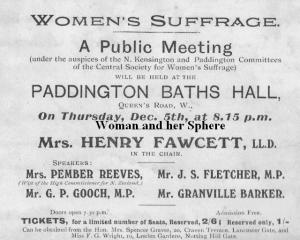 At 2 o’clock Agnes and I started off to Linden Gardens and called for Alexandra Wright and several of her helpers and we all walked to the Paddington Baths to help arrange the room for the meeting in the evening. There was a good bit to do – numbering the chairs – partitioning them off and hanging up banners and posters etc. Left [home again] just before 7 o’clock in a bus to Royal Oak and went to the Paddington Baths for the London (Central) Society’s meeting for Women’s Suffrage. Gladys and Alexandra have been weeks getting it up and I did no end of clerical work for it at Bourne End. We were the first Stewards to arrive after Gladys and Alexandra and were decorated with rosettes and given our directions. Lots of the women were very nervous of a row. My department was the gallery, to look after people up there and give invitations for a private meeting next week.
At 2 o’clock Agnes and I started off to Linden Gardens and called for Alexandra Wright and several of her helpers and we all walked to the Paddington Baths to help arrange the room for the meeting in the evening. There was a good bit to do – numbering the chairs – partitioning them off and hanging up banners and posters etc. Left [home again] just before 7 o’clock in a bus to Royal Oak and went to the Paddington Baths for the London (Central) Society’s meeting for Women’s Suffrage. Gladys and Alexandra have been weeks getting it up and I did no end of clerical work for it at Bourne End. We were the first Stewards to arrive after Gladys and Alexandra and were decorated with rosettes and given our directions. Lots of the women were very nervous of a row. My department was the gallery, to look after people up there and give invitations for a private meeting next week.
The people came in thick and fast and the doors were opened at 7.30 and with the first group of young men below in the free seats I knew what would happen. The place was soon hot, bubbling over with excitement, and I had my work cut out keeping gangways clear and looking after people and telling them they would be safe. We had expected an exciting evening but this realised our worst expectations. It was Bedlam let loose. A couple of hundred students from St Mary’s and University College Hospitals arrived and insisted on sitting together and never ceased all the evening singing, shouting, blowing tin trumpets, letting off crackers, letting loose mice and, what is worse, scenting the floor with a most terrible-smelling chemical.
From the very start they never gave a single speaker a moments hearing. Mrs Fawcett was in the Chair and Lady Groveand others spoke and they went on with the meeting to the bitter end – and bitter it must have been to the speakers. I never heard a word. I felt too angry to be frightened though I must own I did not like the fireworks and saw the most appalling possibilities in that frantic howling mob of mad animals. Agnes owns to being terrified – all the more credit to her for sticking to her place amongst them and she was with them all the evening. I felt mad at not being there in the midst of them. When I could leave I just went down and spoke to John, who I saw standing near Agnes. She had decorated him as a Steward to help in case the worst happened.
I went back to my post until I was no longer any good there and then I went into the very midst of the seething mass and talked to any of them I could get at. Just to silence them, as I did for a few minutes at a time, was a triumph. Cries of ‘Oh I think I like Suffragettes’ as I went amongst them and, then, ‘He is flirting with a Suffragette’ taken up and sung by them all. I spoke like a Mother to several and smiled at them. If they had only known my true feelings I don’t think they would have been so polite to me. Great credit to all the women in the building is due – not only the Stewards – but the audience there. There was never any excitement or panic amongst them and only one Stewardess failed us. She, poor thing, was so terrified she bolted without waiting for hat or coat – but of course we keep that dark. The men Stewards were very good but quite powerless to stop the noise and hubbub. And what could four policemen do? It was an organised ‘Rag’ and nothing but a force of police to outnumber them could have stopped them. They longed for a fight and said so – and no end of them had most terrible looking clubbed sticks which they brandished. We did the only possible thing, I consider. Kept as much order as we could and tried to avoid bloodshed. We had a little unfortunately when, after the meeting was over, they charged for the Platform, sweeping everyone before them. Very fortunately there were large exit doors each side of the platform and most of the people got out of them. I was flung aside and then followed them up. They tore down as many banners as they could and stole one and tore down all the posters. They were like wild cats. The policemen chased them round a little but we would not allow any arrests to be made. The firework ringleader was caught but allowed to go. I spoke to Mrs Wright – red with rage. Poor things, we were all either red or white. Mr Willis, Mrs and Miss Doake and several others. Mr Percy Harris was Stewarding. One man Steward got a most awful crack on the ear and was considerably blooded – he looked awful. Several of the boys had their collars torn off and became very proud in consequence. It was a great wonder and a still greater mercy that more damage was not done. I felt so responsible for the ordinary public who had paid their money. I could only hope to get over the evening safely for their sakes. Personally I wished and still wish to smash the Boys, though at times I could not help laughing. They were not nice boys – all plain and common looking – mostly undersized and no gentlemanly looking one amongst them. I was glad to notice that as I hope they are not the best we can show in our hospitals.
After the general public had gone the police sent word that it was impossible to clear the hall while there was a woman left in it so we left with Mrs and Miss Doake and all came back in the bus with Mrs Willis. Miss Doake said she had never enjoyed a night so much in her life before. I cannot say the same. It was a terrible experience. We could not lose that terrible smell from our noses and mouths. I could taste it through everything at supper. John came home with us and did not leave till after 12o’clock. Agnes and I were too excited to go to bed and sat talking of our experiences. Lots of people will be made all the keener through it, but a great many will be very disgusted I fear.’
 As you can see from this note, carefully preserved by Kate, Mrs Fawcett’s meeting was re-arranged for early 1908 – to be held in the safety of Bertha Mason’s house in nearby Hyde Park Square.
As you can see from this note, carefully preserved by Kate, Mrs Fawcett’s meeting was re-arranged for early 1908 – to be held in the safety of Bertha Mason’s house in nearby Hyde Park Square.
Campaigning for the Vote: Kate Parry Frye’s Suffrage Diary edited by Elizabeth Crawford
For a full description of the book click here
Wrap-around paper covers, 226 pp, over 70 illustrations, all drawn from Kate Frye’s personal archive.
ISBN 978 1903427 75 0
NOW OUT OF PRINT, ALAS
KATE’S DIARIES AND ASSOCIATED PAPERS ARE NOW HELD BY ROYAL HOLLOWAY COLLEGE ARCHIVE
